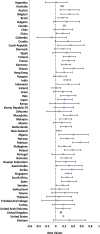Sex and age differences in "theory of mind" across 57 countries using the English version of the "Reading the Mind in the Eyes" Test
- PMID: 36584298
- PMCID: PMC9910622
- DOI: 10.1073/pnas.2022385119
Sex and age differences in "theory of mind" across 57 countries using the English version of the "Reading the Mind in the Eyes" Test
Abstract
The "Reading the Mind in the Eyes" Test (Eyes Test) is a widely used assessment of "theory of mind." The NIMH Research Domain Criteria recommends it as one of two tests for "understanding mental states." Previous studies have demonstrated an on-average female advantage on the Eyes Test. However, it is unknown whether this female advantage exists across the lifespan and across a large number of countries. Thus, we tested sex and age differences using the English version of the Eyes Test in adolescents and adults across 57 countries. We also tested for associations with sociodemographic and cognitive/personality factors. We leveraged one discovery dataset (N = 305,726) and three validation datasets (Ns = 642; 5,284; and 1,087). The results show that: i) there is a replicable on-average female advantage in performance on the Eyes Test; ii) performance increases through adolescence and shallowly declines across adulthood; iii) the on-average female advantage is evident across the lifespan; iv) there is a significant on-average female advantage in 36 out of 57 countries; v) there is a significant on-average female advantage on translated (non-English) versions of the Eyes Test in 12 out of 16 countries, as confirmed by a systematic review; vi) D-scores, or empathizing-systemizing, predict Eyes Test performance above and beyond sex differences; and vii) the female advantage is negatively linked to "prosperity" and "autonomy," and positively linked to "collectivism," as confirmed by exploratory country-level analyses. We conclude that the on-average female advantage on the Eyes Test is observed across ages and most countries.
Keywords: age differences; cognitive empathy; cross-cultural; reading the mind in the eyes; sex differences.
Conflict of interest statement
The authors declare no competing interest.
Figures






References
-
- Baron-Cohen S., Mindblindness: An Essay on Autism and Theory of Mind (MIT Press, 1995), 10.1027//0269-8803.13.1.57. - DOI
-
- Baron-Cohen S., “Theory of mind and autism: A fifteen year review” in Understanding Other Minds: Perspectives From Developmental Cognitive Neuroscience, Baron-Cohen S., Tager-Flusberg H., Cohen D. J., Eds. (Oxford University Press, 2000), pp. 3–20.
-
- Baron-Cohen S., Theory of mind and autism: A review. Int. Rev. Res. Ment. Retard. 23, 169–184 (2004), 10.1016/s0074-7750(00)80010-5. - DOI
Publication types
MeSH terms
Grants and funding
LinkOut - more resources
Full Text Sources
Miscellaneous

